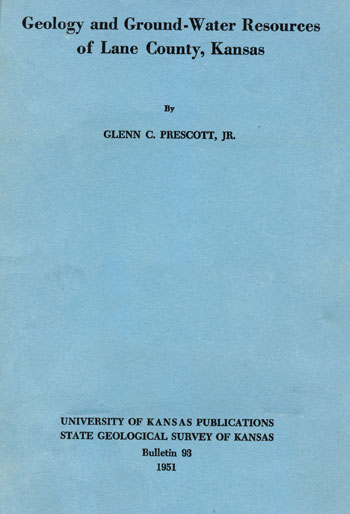Geology and Ground-water Resources of Lane County, Kansas
By Glenn C. Prescott, Jr.

Originally published in 1951 as Kansas Geological Survey Bulletin 93. This is, in general, the original text as published. The information has not been updated.
You may also wish to visit our web site on the Lane County geologic map.
Abstract
This report describes the geography, geology, and ground-water resources of Lane County in western Kansas. Lane County has an area of 720 square miles and in 1946 had a population of 2,626. The area consists of nearly flat to gently rolling upland plains, dissected on the north, east, and southeast by streams which have eroded away surficial materials exposing the underlying Cretaceous shale and limestone. A small basin in southwestern Lane County extends southwestward into Finney County where it may join the Scott-Finney Basin. A small area in the southwestern part of the county is mantled by dune sand. The climate is subhumid to semiarid, the average annual precipitation being about 19 inches. Farming and cattle raising are the principal occupations in the area. There is a very small amount of irrigation from deep wells in the north-central part of the county.
The outcropping rocks are sedimentary and range in age from Upper Cretaceous to Recent. A map showing the rock formations that crop out is included in the report. Much of the area is underlain by deposits of the Ogallala formation of Tertiary age, which is generally covered by wind-blown silts of the Sanborn formation of Pleistocene age. Cretaceous rocks have been exposed by stream erosion on the northern, eastern, and southeastern borders of the county. Thin deposits of Recent alluvium occur along some of the stream valleys.
Lane County has no permanently flowing streams, but contains the headwater areas of Walnut Creek and also is drained by tributaries to Smoky Hill River on the north and tributaries to Pawnee River on the south.
The Ogallala is the principal water-bearing formation in Lane County. The Meade (?) deposits in the southwestern part of the county furnish water for a few wells and the alluvium along some of the streams yields small amounts of water. A few wells may obtain a little water from the Niobrara formation, and deep wells in the Dakota yield water where shallow supplies cannot be obtained.
The report contains a map of the area showing the locations of wells for which information was obtained and showing, by means of shading, the depth to water level. The water table ranges in depth from about 110 feet in the northwest to less than 5 feet in the center of a basin in southwestern Lane County. A map, showing by means of contours the shape and slope of the water table, demonstrates that ground water moves in a general easterly direction with an average gradient of about 10 feet to the mile. A map showing the thickness of saturated water-bearing materials indicates that shallow ground-water supplies available to wells are scarce throughout much of the county.
The ground-water reservoir is recharged principally by precipitation that falls within the area and from precipitation that falls in adjacent areas to the west and enters Lane County as underflow. Ground water is discharged from the ground-water reservoir by transpiration and evaporation in areas of shallow water table, by movement into adjacent areas, by springs, and by wells. Most of the domestic, stock, public, and irrigation supplies are obtained from wells.
Irrigation is not practiced extensively in Lane County, as geologic and hydrologic conditions prohibit any great development. The area most favorable for the development of irrigation supplies lies in T. 17 S. and extends from the Scott County line eastward for about 16 miles.
The ground water in Lane County, though generally hard, is suitable for most purposes. Waters from Ogallala, Meade (?), and alluvial deposits are similar in chemical character, although Ogallala waters are higher in fluoride content. Dakota waters are high in dissolved solids but are soft, probably owing to a natural base-exchange process. Waters from both the Ogallala and Dakota are generally high in fluoride. The Dakota waters are unfit for irrigation.
The report contains a section in which character, thickness and distribution, age and correlation, and water supply of the rock formations are described. These are also briefly summarized in tabular form.
The field data upon which most of this report is based are given in tables; they include records of 303 wells, chemical analyses of water from 31 representative wells, and logs of 41 test holes and wells, including 33 test holes drilled by the State Geological Survey.
Kansas Geological Survey, Geology
Placed on web Jan. 18, 2008; originally published Sept., 1951.
Comments to webadmin@kgs.ku.edu
The URL for this page is http://www.kgs.ku.edu/General/Geology/Lane/index.html